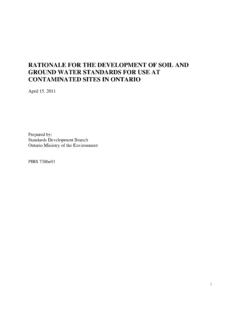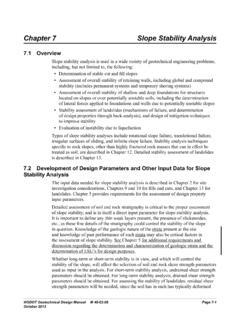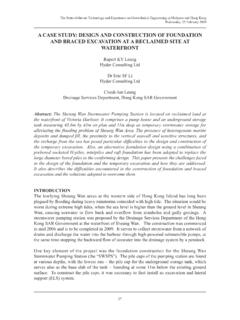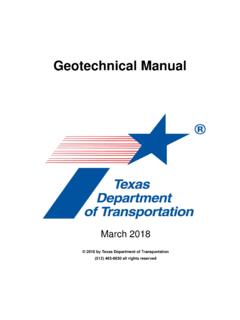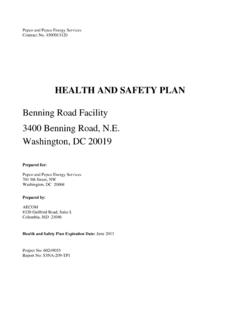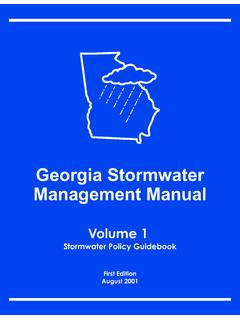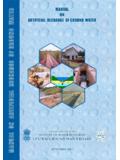Transcription of Stormwater Management Planning and Design Manual
1 March 2003 Ministry of theEnvironmentStormwater Management Planning andDesign ManualStormwater Management Planningand Design ManualMarch 2003 Cette publication techniquen est disponible qu en : Queen s Printer for Ontario ,2003 This publication may be reproduced for non-commercial purposes with appropriate 0-7794-2969-9 PIBS 4329ePrinted on recycled paperPREFACEThe "state-of-the-art" of Stormwater Management has been rapidly evolving and this Manual isone step in this evolutionary process. The Manual provides technical and procedural guidance forthe Planning , Design , and review of Stormwater Management practices. It is important that themanual be viewed as a tool for understanding the performance requirements of stormwatermanagement projects and not as a rulebook for all Stormwater Management Manual provides practical guidance which has been found effective in specific , users must exercise judgement and flexibly adapt the guidance provided.
2 Stormwatermanagement solutions need to consider specific site conditions and this must be recognized whenapplying the guidance provided in the is not the intent of the Ministry to limit innovation with the Manual . Significant effort has beenmade to write the Manual in a manner that does not inadvertently restrict creative solutions. TheMinistry encourages the development of innovative designs and technologies. Where the designercan show that alternate approaches can produce the desired results or even better, such designsshould be considered. However, the designer is responsible for the designs which are made withrespect to Stormwater Management for any given site. This Manual should be used in conjunctionwith other established manuals and practices.
3 It updates the Stormwater Management PracticesPlanning and Design Manual (June 1994).This Manual will also be used as a baseline reference document in the review of stormwatermanagement applications for approval under section 53 of the Ontario Water Resources Act asadministered by the Ministry of the project was initiated and funded by the Ontario Ministry of the Environment. It was alsofunded and supported by the Government of Canada s Great Lakes Sustainability Fund (GLSF),Credit Valley Conservation, and the Toronto and Region Conservation Authority. The followingagencies and staff participated on the steering Ministry of the Environment (MOE)Jonathan P ng (Project Officer)Dale HenryLjuba SimovicStewart ThornleyCredit Valley Conservation (CVC)Hazel BretonGreat Lakes Sustainability Fund (GLSF)Sandra KokToronto and Region Conservation Authority (TRCA)Glenn MacMillanConservation OntarioRepresented by CVC and TRCAD epartment of Fisheries and OceansWayne HyattChristine StonemanOntario Ministry of Natural Resources (MNR)Les PatakyOntario Ministry of Transportation (MTO)Hani FarghalyWilliam SnodgrassMunicipal Engineers Association (MEA)
4 Jeff SmylieNational Water Research InstituteJiri MarsalekEditing and technical review of the Manual was done by Andrea Bradford and Cristina Giannetas(MOE). Helpful guidance was provided by Phyllis Miller and Hardy Wong of MOE. Dale Taylorand Scott Macleod of the Ministry of Municipal Affairs and Housing (MMAH) providedcomments on Chapter 5. Other stakeholders participated in the workshops and provided inputinto the development of the consultants for the project were Aquafor Beech Ltd. (Dave Maunder) and Marshall MacklinMonaghan Ltd. (Doug Andrews) in association with the Centre for Watershed Protection andEnvironmental Water Resources SUMMARYS tormwater Management is required to mitigate the effects of urbanization on the hydrologiccycle including increased runoff, and decreased infiltration, of rain and snowmelt.
5 Without properstormwater Management , reduced baseflow, degradation of water quality, and increased floodingand erosion can lead to reduced diversity of aquatic life, fewer opportunities for human uses ofwater resources, and loss of property and human Planning integrates environmental and land use Planning . Criteria for the protection ofwater quantity, water quality, habitat, and biota are established to help achieve the goals set forthe watershed. Strategies to manage human activities within the watershed are developed to meetprotection criteria. A Stormwater Management strategy may include protection of natural areas, Design of communities to reduce Stormwater generation, and pollution prevention programs, aswell as the Stormwater Management practices which are the focus of this technical combination of lot level, conveyance, and end-of-pipe Stormwater Management practices areusually required to meet the multiple objectives of Stormwater Management : maintaining thehydrologic cycle, protection of water quality, and preventing increased erosion and level and conveyance controls may be classified as storage or infiltration controls.
6 Storagecontrols are designed to detain Stormwater . Although the volume of runoff does not decrease,the risk of flooding is reduced because all the Stormwater runoff does not arrive at the stream atthe same time. Infiltration controls are necessary for soil moisture replenishment and groundwaterrecharge. They can achieve water quality enhancement but are ideally suited for infiltration ofrelatively clean Stormwater including rooftop and foundation drainage. Pre-treatment of roaddrainage is necessary to prevent clogging of a system and to protect groundwater Stormwater Management practices must control the effects of urbanization whichremain after preventative techniques and lot level and conveyance measures have been facilities are usually required for flood and erosion control and water qualityimprovement, although lot level and conveyance controls can reduce the size of the end-of-pipefacilities guidance is provided for individual lot level, conveyance, and end-of-pipe practices.
7 Itincludes physical constraints to the use of the practices, such as, soil type and depth togroundwater; sizing and configuration; and Design details which vary considerably but whichmay include inlets and outlets, filter media, and distribution pipes. The guidance also includescold climate considerations and the incorporation of vegetation in maintenance is critical to the successful performance of a Stormwater Management the first two years of operation, inspections after significant storms will ensure that thesystem is functioning properly. After this, annual checks may be done to identify maintenanceneeds. Blockages may need to be cleared from inlets and outlets. Unhealthy vegetation may needto be tended or replaced.
8 The Design of Stormwater Management practices for water qualityimprovement is based primarily on settling of sediment. Therefore, at some point, accumulatedmaterial will need to be preferred Stormwater Management system will be selected based on its cost, as well as otherfactors such as technical feasibility, effectiveness, and social acceptability. The overall cost mustinclude capital, operating, and maintenance costs. Information provided may be used forpreliminary estimates of cost. However, refinement of estimates to reflect site-specificconsiderations will be i -TABLE OF History of Manual .. Manual Hydrological Effects of Urban Development and Their Impactson Ecosystems .. Environmental and Municipal Land Use Planning .
9 Urban Stormwater Management Practices .. Environmental and Municipal Land Use Planning .. Managing for Required Expertise .. Watershed Subwatershed Plan .. Environmental Management Plan .. Environmental/ Stormwater Management Review Integrated Planning for Stormwater Watershed Scale Solutions .. Community Scale Subwatershed Plans and Cumulative Impacts .. Alternative Plans and Cumulative Evaluation and Cumulative Impacts and Land Use Design General .. Water Balance .. Water Balance Methods .. Water Balance Example .. Water Criteria Development .. Level of Protection .. Water Quality Sizing Criteria .. Results of monitoring SWMP Other Considerations.
10 Temperature ..3-13- ii -TABLE OF CONTENTS (cont d) Erosion Control/Geomorphology .. Geomorphology Detailed Design Approach .. Simplified Design Approach .. Application of Simplified Design Overview of Technical Water Peak Flow Rate Criteria .. Potential Impacts of Attenuated Stormwater Management Practice Selection and Management PLAN AND SWMP General .. Lot Level and Conveyance Controls .. End-of-Pipe Controls .. Siting of Stormwater Management Design Modifications for Cold Volume Modifications to Inlet and Outlet Mitigation Measures for Increased Lot Level and Conveyance Rooftop Parking Lot Storage .. Superpipe Reduced Lot Grading .. Roof Leader to Ponding Areas.



